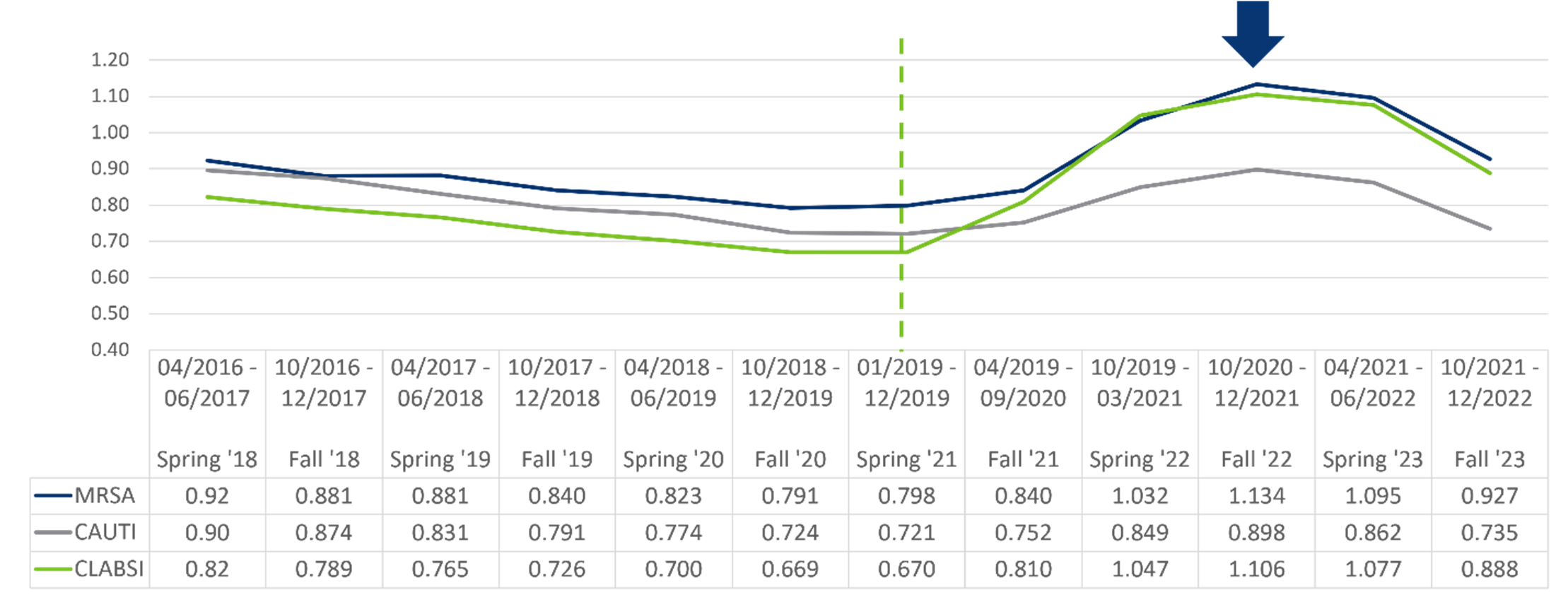Press Inquires
We are happy to help members of the press inform the public about the Leapfrog Hospital Safety Grade. For interview requests or additional information for print, electronic and broadcast journalists, please contact:
If you are a hospital looking for a template press release to announce your Leapfrog Hospital Safety Grade, please contact PR@leapfrog-group.org.
New Fall 2023 Hospital Safety Grades from The Leapfrog Group Find Improved Infection Rates Following Major Spike During COVID-19 Pandemic
WASHINGTON, November 6, 2023—The Leapfrog Group, an independent national nonprofit driving a movement for patient safety, today released its fall 2023 Hospital Safety Grades, assigning a letter grade to nearly 3,000 general hospitals on how well they prevent medical errors, accidents and infections. The latest grades show hospitals reducing health care-acquired infections (HAIs) post-pandemic, after significant increases in infection rates during the COVID-19 pandemic. This cycle, nearly 30% of hospitals earned an “A,” 24% earned a “B,” 39% earned a “C,” 7% earned a “D,” and less than 1% earned an “F.”
Utah is the state with the highest percentage of “A” hospitals in the country this fall. After Utah, the top ten states for “A” hospitals are: Virginia, North Carolina, Pennsylvania, South Carolina, Connecticut, Montana, Tennessee, Florida and Texas. States with the least favorable performance are Vermont, Wyoming, Delaware, Washington, DC, and North Dakota, where no hospitals earned an “A.”
“Now that we have pre- and post-pandemic data for patient safety measures, we are encouraged by the improvement in infections and applaud hospitals for reversing the disturbing infection spike we saw during the pandemic,” said Leah Binder, president and CEO of The Leapfrog Group. “However, there’s still more work to be done. It’s deeply concerning that patient reports about their health care experience continues to decline.”
The new grades are the first to reflect hospital performance post-pandemic. Nationally, hospitals significantly reduced three HAIs—Methicillin-resistant Staphylococcus aureus (MRSA), central line-associated bloodstream infections (CLABSI) and catheter-associated urinary tract infections (CAUTI)—after CLABSI, MRSA and CAUTI reached a 5-year high during the pandemic. In the fall 2022 Safety Grade cycle, hospitals experienced a 35% increase in the average standard infection ratios (SIRs) of CLABSI and MRSA from pre-pandemic levels as well as a 20% increase in CAUTI.
The latest data shows that over 85% of hospitals have improved performance on at least one of the three dangerous infections the Hospital Safety Grade accounts for. That includes:
- 19% of hospitals have improved in all three infection measures,
- 66% of hospitals have improved at least one infection measure, and
- 16% of hospitals have continued to worsen or made no improvement.
HAI SIRs National Average Per Hospital Safety Grade Cycle

The Leapfrog Hospital Safety Grade also includes five patient experience measures that evidence suggests are closely associated with patient safety issues. The scores for the measures are calculated using patient responses to a national and standardized patient survey following a hospital visit. Patients are asked to rate their experience of nurse communication, doctor communication, staff responsiveness, communication about medicine, and discharge information. Nationally, patient experience scores worsened for the second year in a row, and all states experienced a significant decline in reported patient experience from the fall 2021 to the fall 2023 Safety Grade.
Patient experience reports show the most significant declines in the categories of “communication about medicines” and “responsiveness of hospital staff,” both of which correlate with preventable medical errors according to recent studies, Binder reported.
States with the Most Significant Declines in Five Categories of Reported Patient Experience Fall 2023 Leapfrog Hospital Safety Grade
|
Category of Patient-Reported Experience |
Nurse Communication |
Doctor Communication |
Staff Responsiveness |
Communication about Medicines |
Discharge Information |
|
States with |
New Mexico |
New Mexico |
New Hampshire |
Florida |
New Mexico |
|
Florida |
Florida |
Connecticut |
Nevada |
Florida |
|
|
New York |
Hawaii |
Arizona |
New Mexico |
Nevada |
|
|
New Hampshire |
West Virginia |
New York |
Arizona |
Arizona |
|
|
Arizona |
California |
Florida |
Alabama |
New Hampshire |
“In talking with hospital leaders, we believe staffing shortages are one key reason for the continued decline,” said Binder. “Many hospitals are innovating to help make patient experience better, which is critical because these results are disheartening and unsustainable.”
The Leapfrog Hospital Safety Grade is the only hospital ratings program based exclusively on hospital prevention of medical errors and harms to patients. It is fully transparent and free to the public, and grades are updated biannually in the fall and in the spring. For more information about the Hospital Safety Grade, including details on individual hospital grades and state rankings, please visit HospitalSafetyGrade.org.
About The Leapfrog Group
Founded in 2000 by large employers and other purchasers, The Leapfrog Group is an independent national nonprofit organization driving a movement for giant leaps for patient safety. The flagship Leapfrog Hospital Survey and new Leapfrog Ambulatory Surgery Center (ASC) Survey collect and transparently report hospital and ASC performance, empowering purchasers to find the highest-value care and giving consumers the lifesaving information they need to make informed decisions. The Leapfrog Hospital Safety Grade, Leapfrog's other main initiative, assigns letter grades to hospitals based on their record of patient safety, helping consumers protect themselves and their families from errors, injuries, accidents, and infections. For more, follow us on Twitter and Facebook, and sign up for our newsletter

